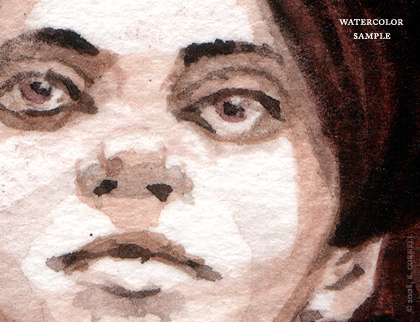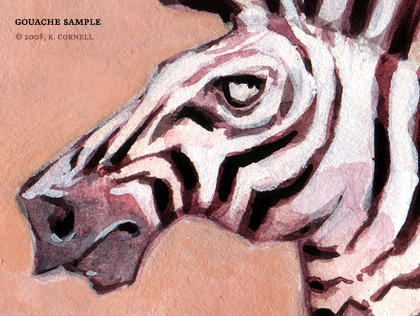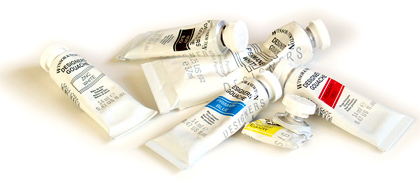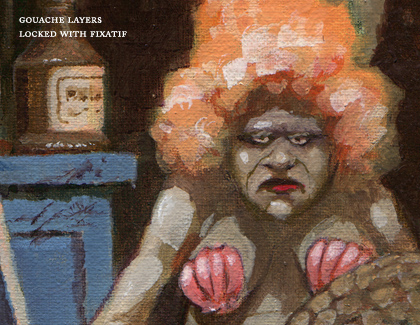The Professional Webspace of Designer and Illustrator Kevin Cornell:
"Design, Art, and Lackluster Humor."
Painting Tools
A couple of weeks ago I shared some information on what sort of tools I use for drawing roughs, including pencils, erasers, and other relevant doodads. The installment after that dealt with the tools I need for black and white art. This week I'll be sharing those very few tools I need for painting.
My Two Mediums
While I have dabbled in a variety of painting mediums, there's really only two that I could be considered proficient enough to give recommendations on: watercolor and gouache. I'll briefly sum up their differences.
Watercolor is the more delicate of the two; you work in washes, and all the lightness in the painting comes from the paper. Watercolor's chief virtue is its transparency; as you stack up wash after wash, brushstroke after brushtroke, you get a painting with pretty amazing depth. Unfortunately, watercolor is not very forgiving. It's the paint equivalent of my dog; it does what it wants, and you either have to accept how it behaves or go crazy.

Gouache is a better medium for those of us fated to screw up occasionally while painting. The beauty of gouache is that, while it can behave like watercolor, and be used for light transparent washes, it can also be used opaquely. Meaning that if you want to put a lighter tone on top of a darker tone, you can just spread on a thick layer of gouache, just like you would with acrylic or oil paints. Another side benefit of gouache is that it reproduces more true-to-life than watercolor. I could never get a good scan of a watercolor painting; but gouache tends to look just how I painted it when I scan it in.

Now, since this article is really about tools, not technique, and I use pretty much the same tools for painting in both mediums, I've decided to just sort of focus on the gouache side of things. If I wanted to use watercolor instead, all I'd really do differently is buy tubes of watercolor paint instead of gouache. And I'd have more paper on hand for when I have to start over.
On What Colors To Buy

These are my gouache paints. As you can see, I don't have a lot, and that's because you're better off not having a lot. I prefer to mix all my colors, just using blue, red, and yellow. Occasionally, if I want a more complex palette, I'll use the blue, red, and yellow you see above to create a warm palette, and then purchase an Ultramarine, an Alizaron Crimson, and a Yellow Ochre to create a cool palette for shadows. But that's just one possible approach, and not always necessary.
There's not near enough room to go into all the different variations one could use in creating a palette, but there is one important tip that anyone starting to mix their own colors should know (if they don't already): when creating your palette, take one color and mix it slightly into all the rest. This creates a harmony between the colors, and allows you to use any of the colors in your palette without fear that it will look out of place. If that's something that concerns you.
Two key components to using gouache are your whites. I have a Permanent White, which is a thicker, more opaque white, and a Zinc White, which is a naturally thin white, and is quite transparent. I use permanent white when I'm trying to build light on dark. The zinc white is great for light washes over other colors without drastically changing things.
I also have a black. Some people say you should never use black in a painting1; some people use it like it's the only color in the palette. Personally, I think whether or not you should use it depends on your style of painting; sometimes it looks appropriate, sometimes it doesn't. I will say, if you do plan to incorporate black, make sure you add a little of your harmonizing color to make sure it fits with the rest of your color.
On What Brushes To Buy
I don't use a lot of brushes, which isn't to say having a lot of different sizes and shapes isn't helpful. There are certain marks that only some brushes can make; and painting becomes much easier if you're using the right brush for the right mark. In the same way that it's much easier to drive a nail with a hammer than a screwdriver.
I'm not going to get too specific about what size and make of brushes I'm using here2. This is really more of a guide for how to design your own, versatile set of brushes. What it comes down to, is that you buy a brush when you need it; you don't buy seven brushes and force yourself to use them all if your particular style only calls for 3 brushes. The following set of brushes really work out well for me:
Big, Huge Brush

This guy is handy for big huge washes, areas where I need to get a lot of color down real fast before it dries, in order to avoid overlapping edges. He's about an inch across, and 1.5 inches from the ferrule (the metal dealie that connects the bristles to the handle). I stole this guy from Kim.
Angled Brush
This is the same fellow from my inking article, and he measures about a quarter-inch across. He's the real workhorse of all my brushes. I use him to gather up and put down, or "block in", the majority of the color. He's just so versatile. I couldn't be prouder of him.
Fan Brush

I only rarely use this fellow, and it's mostly for feathering out thick or wet areas of paint. It really works best when the bristles are dry, and you lightly brush it inward/outward from wet areas. I stole this one from Pete Dalkner.
Slightly-angled Flat Brush

This is my second most versatile brush — it's wide enough to block in color, but I can also turn it on its tip to add detail. He's about a quarter-inch across in width as well.
Small, Flat Brush

I use this guy when I need to block in paint in small areas, but the detail brush would be too tedious. He measures about an eighth of an inch across. Mostly I use him in faces, or other tight areas with lot of quick color shifting. I stole this one from Kim again.
Little Teeny-Tiny Detail Brush
This is the absolute smallest brush I own. He was originally about a sixteenth of an inch across. As I've used it over the years, the bristles have taken a beating — some of them will occasionally decide that they don't want to be part of the nice tip the rest of the bristles form. When that happens, I have to trim them off with an x-acto knife. I don't know if this is a good or bad practice, but it turns out it's much cheaper than buying a new detail brush every time, so I'm sticking with it.
A Few Finishing Thoughts...
Something I've been attempting lately is using a workable fixative spray to lock layers of my painting. This allows me to more successfully paint on top of existing layers without damaging what's beneath. A word of warning3 on this, however, is that fixatives — even the matte finish ones — tend to leave a glossier coat than gouache does naturally, which may not be something you desire. But I leave that choice up to you.

With regards to scanning, like I mentioned above, gouache scans much better than watercolor, but even so I find I generally have to play with the levels a bit to get what's on screen to match what I painted. I don't recommend using Auto Levels, as that tends to throw off the color completely.
So hopefully that answers some questions about how I work when it comes to painting. Next time, I'll be focusing on paper and sketchbooks. Until then, I suggest you avoid using paper, and just paint on other surfaces. Walls. Floors. Dining Room Tables. Et Cetera.
Footnotes
1The argument being that black is not truly seen in nature, and that even the darkest shadow is just a dark, dark color. Which may be true, but it can be difficult to mix a dark color when all your paint is in a tonal mid-range. Black can help if you can't get a hold of dark tints, which I find IS a problem with gouache, at least when you're buying it in a store.
2If you really want details on brushes, check out this set of downloadable pdfs.
3Another word of warning here is that I'm not sure how well layers of fixative will help preserve the painting. Time will tell. I'm assuming the chemicals in there aren't acidic.
Comments on this Article
There are currently 27 comments.
2. bearskinrug
Look... it was hard enough to stop eating paint when it was JUST paint...
3. aisleen
I've used spray fix on a gouache painting before, and after looking back on it 3 years later, the whole thing is yellow-tinted. I don't know if its just because I used sucky spray or what, but I used the same gouache as you. Hope you have better luck!
Oh and thanks for the tip on mixing in one color into the rest on your palette! Great advice
5. glindon marten
Fantastic stuff! I paint in acrylic and oil only, but only because watercolor is so unforgiving like you mentioned. Anyone who can use the medium well has my respect.
7. bearskinrug
9. Jujueyeballs
"In the same way that it's much easier to drive a nail with a hammer than a screwdriver"
How about a shoe? Can I use a shoe?
I like shoes, they're tasty.
10. opspraak
I'm not all too sure on this painting stuff, I'm about as artistically inclined as 4 toe sloth with only two toes - for some manly reason!
However, I do fully agree on the roofie sandwich statement at the bottom! That's something I'd invest money in!
11. Pasquale
I just got into using gouache! I'm always finding it weird when my brush picks up the wrong colour and starts smearing it around.
Do you think it's best to work in a layered approach? I'm curious to know how to lay down colours easily!
12. bearskinrug
Juju - I suppose you could use a shoe... might need a re-cobbling when you're done though.
Opspraak - Not a fan of the afternoon either, eh? We should form a club!
Pasquale - I think it's better to work like a watercolor for the majority of the painting, and then layer on 1 layer when you need to. Unlike acrylic, gouache will always remain water-soluble, even dry, so layering is more difficult (thought much easier to do than it would be with watercolor paint).
13. Phyllis
Wonderful article! As I'm not much of a painter (always try to paint like I draw and the paint rebels, out of principle, I suppose), I love advice from those of you who are far better at it than I am. These are very useful tips .... and it's comforting to know that I'm not the only one who goes through their toolbox, reminiscing: "And this one I stole from So-n-So ... then this little guy I found on the sidewalk on Wabash in Chicago that one day ..." Just a blinking scavenger, I am!
14. greg.newman
Nice writeup Kevin, thanks.
I've used fixative for many many years and it's a necessity in my toolset. I use it mainly for working with graphite, especially after finishing a piece. I've never used it with gouache which is a good idea.
15. Anthony
Now we know what you use, is there any chance of getting a demonstration of how you actually paint a painting?
16. Rob
Yes, Anthony is on to something! Live demonstration please! And thanks for a great series.
17. bearskinrug
Phyllis - Yeah - it's funny how these little inanimate tools are so integral to a person's style; we should always appreciate em!
Greg - Yeah - I definitely use it when I'm working in pencil and charcoal - I only tried using it with gouache after reading the suggestion on the back of some artboard I bought.
Anthony / Rob - I'll think about it - to be honest I always have reservations about creating tutorials (I may go into the reasons why in the next part)...
18. Anthony
It's completely understandable if you don't want to give away all of your secrets. You've already given us a lot of tips with these materials posts, and I really appreciate it all!
19. Lydia Velarde
Hi
I nominated you for this little blog award. You can see it here:
Lydia
20. bearskinrug
Thanks Lydia — I appreciate it - I don't know if I'll participate, though. I kind of steer clear of memes :D
21. samar
really good tips ....kevin,
yes i would wait untill you tell paper types.. it confuses me too when i go to art store.
22. Phyllis
I had to double-take there - I thought you said that you steer clear of *mimes*. Not that I'd blame you, I avoid mimes, too. Talk to you death if you let `em, the chatty buggers!
23. Gerren
In regards to scanning in watercolor paintings, I like the results I get better from using a curve adjustment layer and pushing the mid tones up. Using a levels adjustment layer does the same thing, but tends to wash out any details in the highlights and shadows.
Cool Article.
24. Lucero
That's bearskinrug for you, thanks for this article. I would buy this item. I've searched before on what type of tools will use in this kind of art but, the information I've got has no better description. Anyhow, thanks!
25. glindon marten
Turpentine is awful stuff. I used to wash my brushes with the stuff and not use gloves... I'm pretty sure I'm sterile now.
I think the final step in your tutorial should be 3D computer graphics, it would be cool if it was animated too. I'd love to see the action scene of you killing the farmer to set up your table in his field in glorious CG.
26. Pascal
Thanks for this nice article! Your stuff is a great motivation and inspiration anyway. coming back time and again, even just to feed the bear with fire:) I mostly work with watercolor, just once used Gouache and it did not work out so great, so I am kinda scared to touch it again, maybe I shoud give it another try now that I see your work again.
Anyway, just came here to tell you, I also trim those chaotic "dont want to belong there" hears on my smallest brush, so you are not alone :)
27. davidfromdallas
YOU'RE AN IDIOT!
for not updating your blog more often. your work, words, and wisdom are truly inspirational. i've been meaning to tell you all this for the past four years i've been reading your blog but haven't gotten around to it until today. so in case no one's told you today, you rock. keep jammin'

[ Back to Top ]
Search Bearskinrug:


Other Sections You Might Want To Visit:
- The Downloads Section: Wallpapers for the Discerning Desktop.
- The Links Archive: A Collection of Interesting Tidbits.












1. Christian
I read that as "watercolor and goulash," which would make for a spicy, saucy painting.